Question from Martha P.:
Hello Invention Geek,
Who patented the first corkscrew?
Martha P.
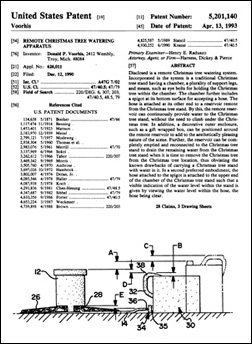 Donald P. Voorhis received US Patent 5201140 on April 13, 1993 for a Remote Christmas Tree Watering Apparatus.
Donald P. Voorhis received US Patent 5201140 on April 13, 1993 for a Remote Christmas Tree Watering Apparatus.
“Because of the undesirable characteristics of watering the Christmas tree, many times this task would be avoided, sometimes causing the water in the Christmas tree stand to be completely drained and thus, creating a fire hazard from a dry Christmas tree, as well as an unpleasant looking tree.”
Question from John M.:
Hello Invention Geek,
Every time I am on the highway, I see a Yellow Freight truck. It has always bothered me that part of the truck and the logo are orange. Why is the Yellow logo orange?
John M.
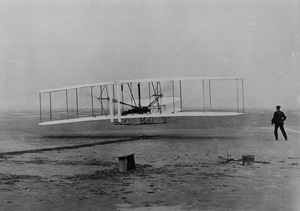 The Wright Brothers built the world’s first successful airplane. On December 17, 1903, the brothers made the first powered flight in North Carolina. The flight last for only 12 seconds with the aircraft only ever reaching a height of 20 feet off of the ground. Still, the flight was ground breaking.
The Wright Brothers built the world’s first successful airplane. On December 17, 1903, the brothers made the first powered flight in North Carolina. The flight last for only 12 seconds with the aircraft only ever reaching a height of 20 feet off of the ground. Still, the flight was ground breaking.
This flight led to the Wright Brothers filing for a patent in 1903. They drafted their first patent application themselves and could not demonstrate a working aircraft. They were denied a patent and the US Patent Office suggested that they work with a patent attorney. Friends referred them to Harry A. Toulmin in Springfield, Ohio.
Toulmin assured Wilbur Wright that he would be able to secure a broad patent that would provide great protection for their invention. On January 22, 1904, Wilbur Wright hired Toulmin to help them with their patent. Toulmin suggested that instead of attempting to patent the entire plane the patent should protect the method of flight control. The flight control method included wing-warping and the three-axis system which controlled the aircraft in forward flight. Continue reading “The Wright Brothers Patent Wars”
Question from Jeremy B.:
Hello Invention Geek,
What are the real names of the men pictured on the Smith Brother’s cough drop logo?
Jeremy B.
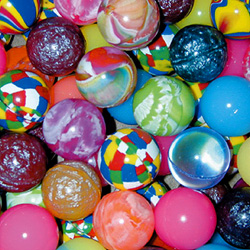 Norman Stingley was not attempting to produce a new fad when he began conducting experiments with highly resilient rubber. The new compound manufactured by Stingley became unbelievably bouncy when compressed under extreme pressure.
Norman Stingley was not attempting to produce a new fad when he began conducting experiments with highly resilient rubber. The new compound manufactured by Stingley became unbelievably bouncy when compressed under extreme pressure.
Stingley was unsure what to do with his new product. He could not figure out a use for this new rubber. He offered the product to his employer, Bettis Rubber Company but they were not interested in the material. The material was not very durable and they feared it would never be marketable.
Eventually, Stingley showed his rubber to Wham-O Manufacturing Company, the very successful makers of the Hula Hoop and Frisbee. The company agreed to work with Stingley on the compound. For nearly two years, they worked to design a more durable rubber. They did finally succeed and produced a rubber that stood up to regular wear known as Zectron. The SuperBall was born. Continue reading “Zectron?”
Question from Warren C.:
Hello Invention Geek,
Is there a process similar to eminent domain that can be excercised by the government to take ownership of a patent or take away exclusive rights by the inventor if the invention is deemed either something valuable for public safety like smoke alarms or something as dangerous as the atomic bomb for example?
Warren C.
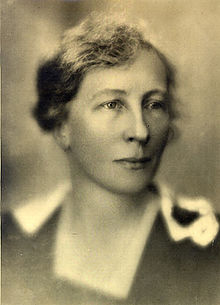 Lilliam Moller Gilbreth is unfortunately best known as the mother from “Cheaper by the Dozen.” In reality, in addition to being the mother of 12 children, she was also an industrial engineer, teacher, author and inventor. She was one of a very few working women engineers. She had a Ph.D. at a time when such a thing was unheard of for a woman and was also the first industrial/organizational psychologist.
Lilliam Moller Gilbreth is unfortunately best known as the mother from “Cheaper by the Dozen.” In reality, in addition to being the mother of 12 children, she was also an industrial engineer, teacher, author and inventor. She was one of a very few working women engineers. She had a Ph.D. at a time when such a thing was unheard of for a woman and was also the first industrial/organizational psychologist.
Gilbreth believed that efficiency could be better accomplished if the workplace was better suited to the worker rather than the worker having to adapt to the workplace. As consultants and teachers, she and her husband trained many managers and companies to better design offices and manufacturing plants to increase productivity by decreasing fatigue.
After the death of her husband, Gilbreth continued working as a consultant to support her 12 children. She changed her focus to the household and the kitchen. As a mother, Gilbreth spent a lot of time in the kitchen cooking meals for her large family. While working as an industrial engineer at GE, she interviewed over 4,000 women to help her design a functional and comfortable kitchen. These interviews led her to design new appliances and products for the kitchen. Gilbreth invented one of the first electric mixers to speed up cooking. She designed shelves for ice boxes to increase storage space and she produced a trash can with a lid. This type of trash can is still found in many kitchens today to keep out bugs and controls smells.
Continue reading “Lilliam Moller Gilbreth: More than “Cheaper by the Dozen””
Question from Simon T.:
What is a poor man’s patent?
Simon T.
Thanksgiving is a holiday all about food. Many of the foods we eat at this massive meal have a convenience counter part that was invented by someone or even patented. Some of these foods like cranberry sauce in a can are now part of many people’s holiday traditions.
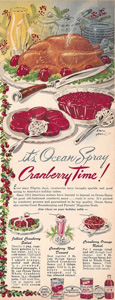
Cranberry Sauce
How many of us sit down for our Thanksgiving dinner and among the other foods there is a log of jelled cranberry sauce? The first canned cranberry sauce was developed in 1912 by lawyer and cranberry farmer Marcus L. Urann. He harvested more berries than he sold during what was then considered cranberry season. In order to profit from these additional berries, Urann developed a way to make sauce that could be canned. He started the Ocean Spray Preserving Company to market his new recipe. In 1941, the log that we think of as cranberry sauce became available.
